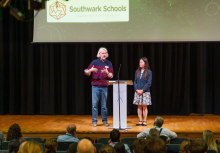






Recently at the Foundation for Education Development (FED), a meeting of state and independent schools to discuss the future of education in this country, I was struck and inspired by one example of state and independent sector working. In Bolton all the schools get together at the beginning of the year for a ‘state of the nation’ discussion. Colloquially called the 19k project, because that is how many children were living in Bolton when the group was formed, they ask what do children growing up in Bolton need? What are they as schools good at giving them? What are the gaps? It is a frank and open conversation between schools of all types and sectors, underlined by a collective responsibility for all of those children. Being frank with one another allows them to be clear about what is needed to improve education in the town and how together they can drive change. This collaboration allows them to understand how they can support each other in a long term and sustainable way. It forms the basis for true partnerships.
We often talk about school partnerships. This is not the private sector's way of paying lip service to their charitable status, because independent schools have quickly realised that working with other schools in their local communities is just as beneficial to them and their pupils as they can be to the state sector schools they work with. In fact, we often see our pupils’ participation in partnership work as crucial to contributing the development of social and practical skills, their sense of place and belonging in their local community and their understanding of society and the wider world. This is a formative part of them becoming responsible and moral citizens.
Our long-term partnerships have been fruitful, they have led us to places we haven’t expected, brought formative experiences to pupils and staff alike. Yes, we are often (but not always) the party in the arrangement that is providing some kind of resource, but when it comes down to who is benefiting, that resource is not the most important matter in mind. What we have learnt over the years is that, for partnerships to deliver most benefit, they need to be long term. There are often opportunities to dip in and out of relationships, but the ones that are truly fruitful are the ones where both schools know and understand where the other is coming from, what they need and what they can offer. To be long term, partnerships need to be sustainable, they need to be achievable and they need to be worth the effort. And in order to be sustainable, they need provide really strategic benefit to both parties. That is where understanding and openness is crucial.
It is really important that political dynamics do not result in a state versus independent sector narrative and, where that narrative exists, we need to challenge it, because that is not what is happening on the ground. There’s very real reason to hope that partnerships will grow stronger and more entrenched as great examples like the collaboration of schools in Bolton (and our own experience as one of 18 schools who make up the Southwark Schools Learning Partnership) are replicated more widely across the country. I believe that this will bring more benefit than punitive policies designed to hamstring the independent sector. The mood at the FED was hopeful, we all want to work together. It’s been refreshing in the light of the Budget and so much else, to feel such a collective sense of purposeful energy, hope and a very real optimism for the future.
